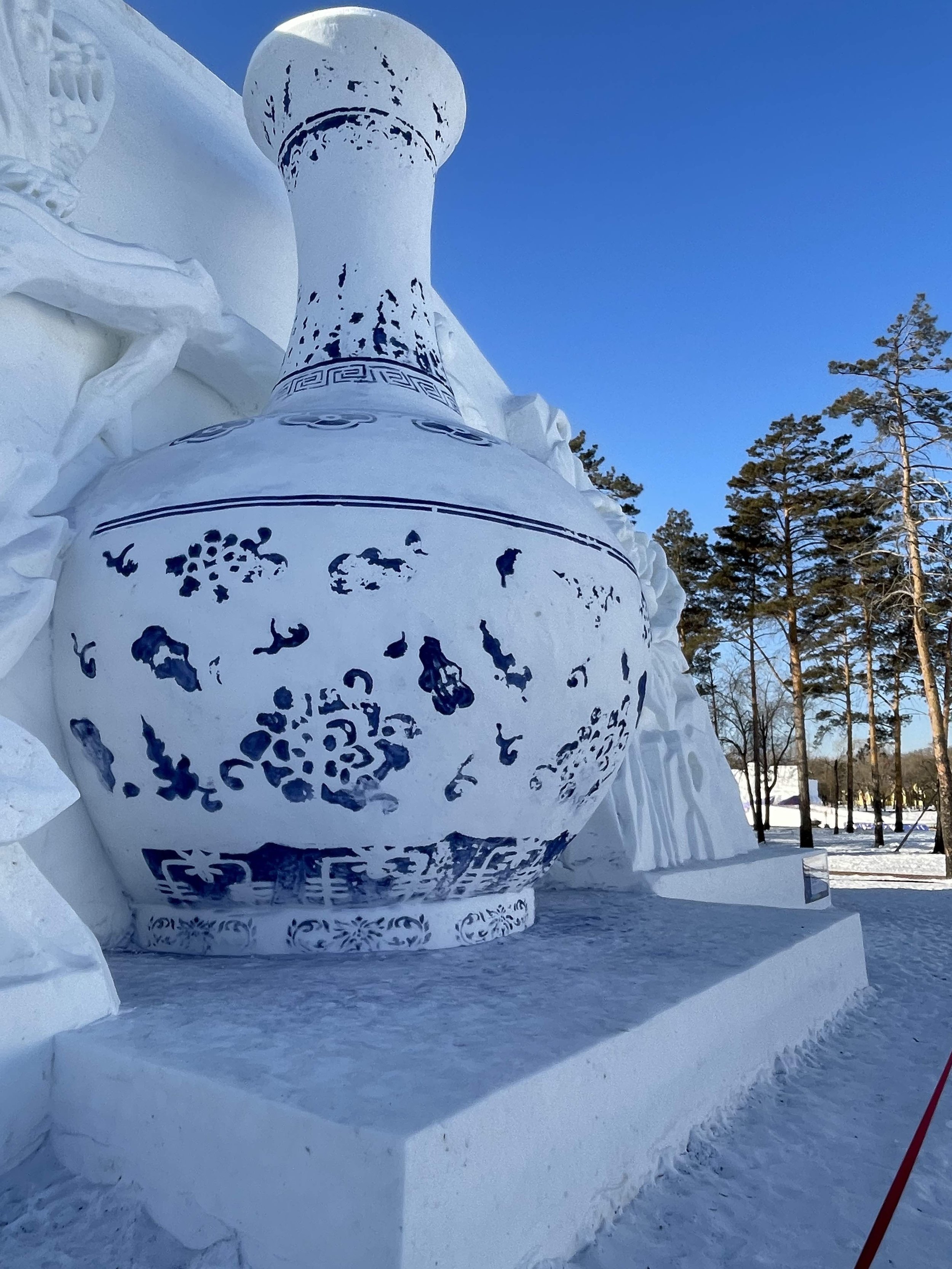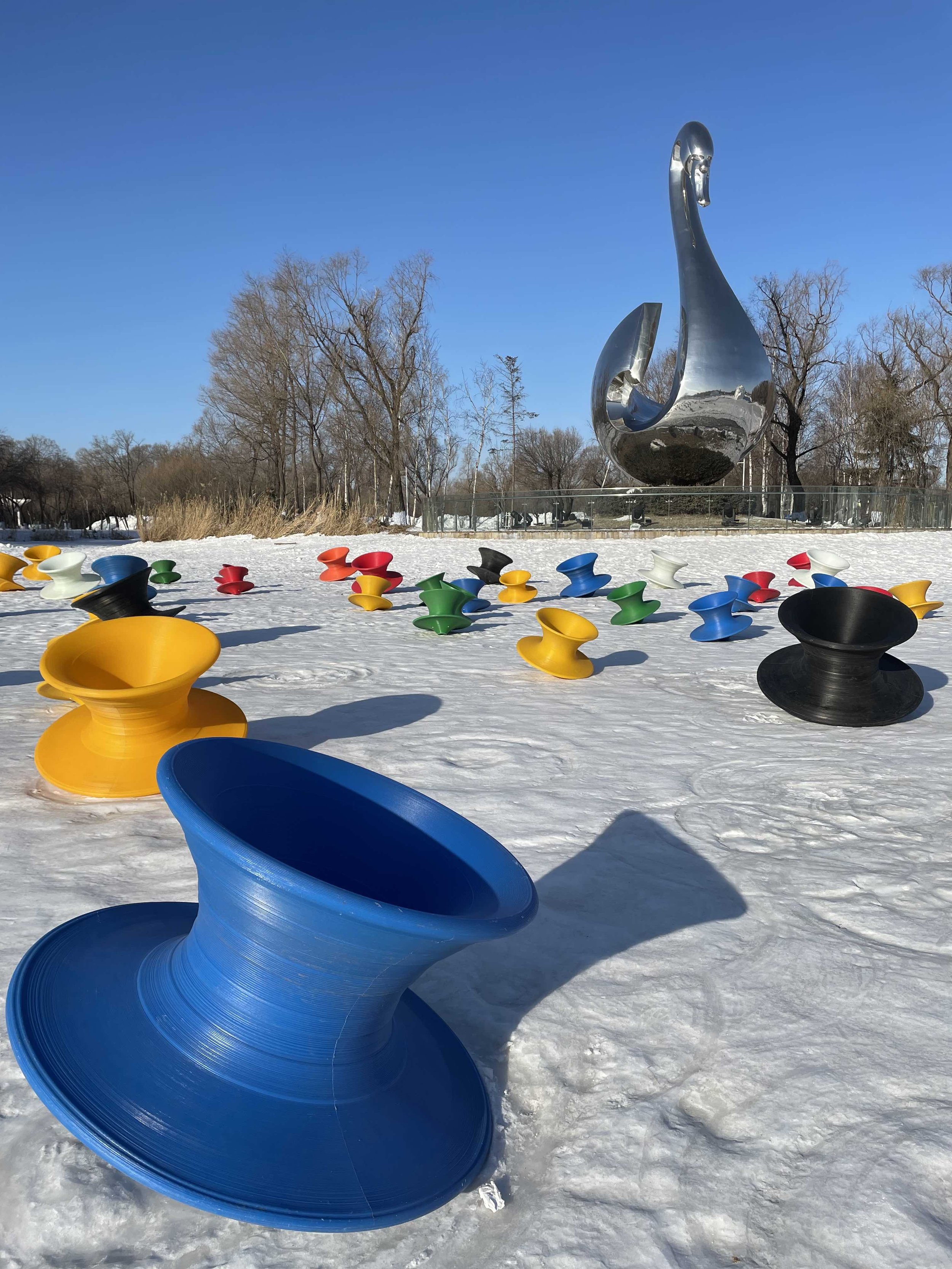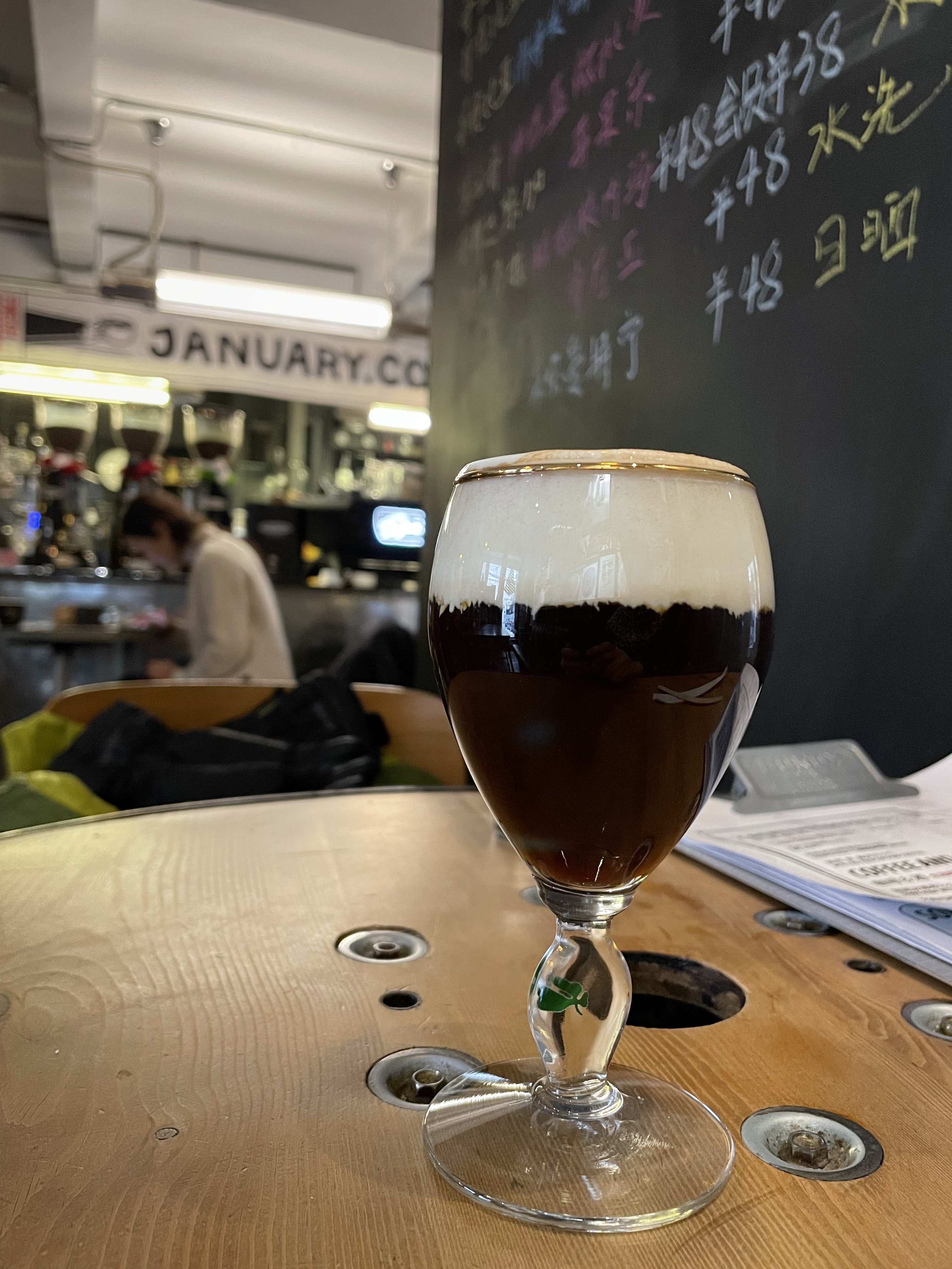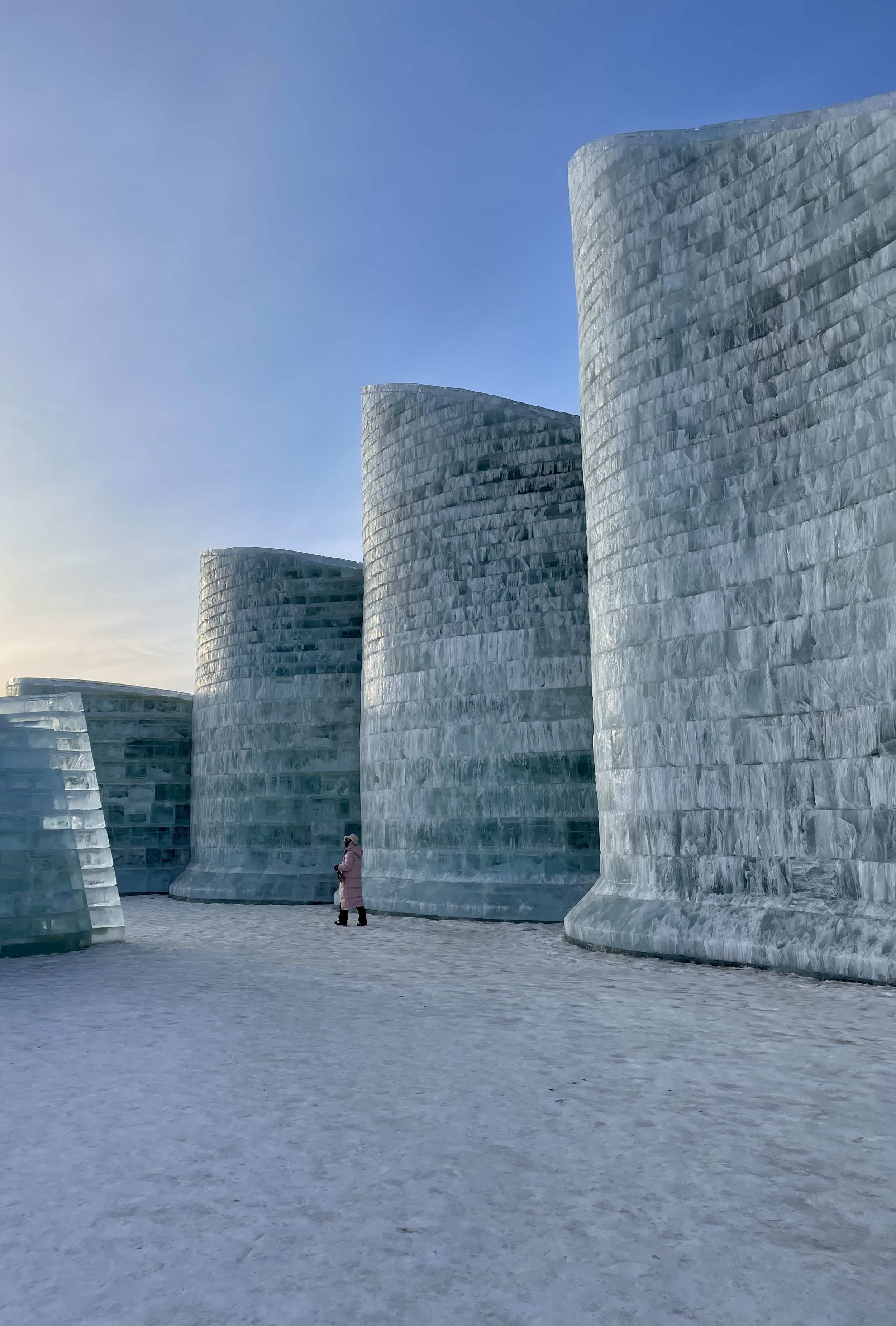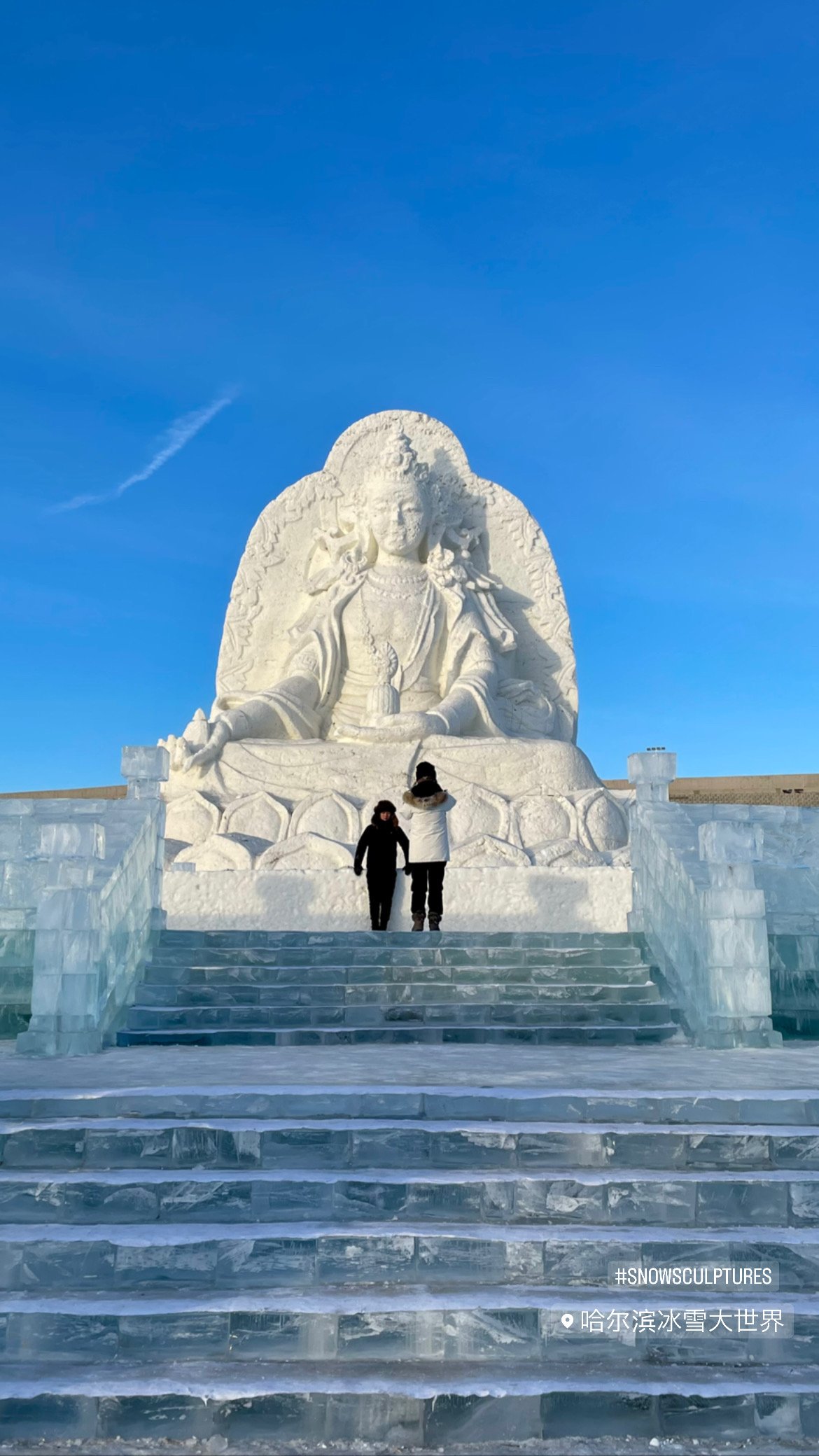A couple of weeks ago, a long held dream came true when I managed to sneak away to the deep freeze of Heilongjiang Province to visit Harbin Ice and Snow World.
Love me a pink and purple onion dome…
I can’t remember exactly when this annual extravaganza of giant snow sculptures and ice-brick buildings first crossed my horizon, but I seem to recall it being some time in the early 90s, when I was languishing in deepest Gunma-ken as the World’s Least Promising English Teacher, aka participant in the JET Programme. What I do remember is that the first time I saw photos, I knew that one day, I would have to go.
I didn’t manage while I was in Japan, even though Harbin was relatively close at the time, certainly much closer than it was during the 20 years I spent in Lebanon, but I never entirely forgot. Every year, I promised myself that it would be ‘next winter in Harbin’, and so you can imagine my frustration then, when after moving to Beijing, which meant that getting to Harbin no longer involved doing battle with the vagaries of Chinese visas or coughing up for a long-distance flight (though even from here, Harbin is still a 1300-km journey), I still couldn’t go because of COVID. And so for the last three winters, although I’ve never been physically closer to Harbin, the festival might as well have been taking place on Mars.
So when travel restrictions relaxed last December, I knew exactly where I was going first. Obviously, Heilongjiang isn’t the warmest of places but as a child of extremes, I like my summers hot and my winters cold. Even so, Harbin pushed my envelope. In the summer, it can pass briefly for Sienna, but in the middle of winter, it reverts to Siberia. Daytime temperatures were a (relatively) balmy -24C the weekend I was there, and I say balmy because the following weekend, they dropped to -33C and then a week after that, Mohe, China’s northernmost city recorded a temperature of -53C.
Suffice to say that it was brisk and that despite exhortations to remain masked, I swiftly abandoned mine as within minutes of being outside, it became soaked with exhaled moisture and froze to my face. Not one to bear calumnies lightly, I didn’t wear one again for the rest of my stay. I wasn’t alone. Many Harbiners weren’t bothering either, likely for the same reason. Frankly, it was a relief. Three years of being almost permanently masked, both indoors and out, have bequeathed me a visceral loathing of PPE, although apparently some people are now finding it hard to give up wearing them.
But back to Harbin.
The festival, about which more later, wasn’t the sole purpose of my visit. As I read up on the city, I discovered that between the 1880’s and 1930s, it enjoyed a cosmopolitan effloresence as a mini-Shanghai - or perhaps more accurately, as a mini-Moscow. For a few decades, it was city of two halves; one Manchurian, the other Russian. Interestingly - for until 1911 China was under Manchu rule (I’m lookin’ at you, Pu Yi) - non-Manchu Chinese were not permitted to settle there, just as old Peking’s Tatar City was also off-limits to Han Chinese residency.
Being both outsider and mutt, I’ve always had a soft spot for these Interzones, places that like Cavafy and his beloved Alexandria, were in if not of their host country. While most historically have been the result of empire or colonialism (and often both), others were sprung of slightly different loins.
In Harbin’s case, that was the railway, specifically the Chinese Eastern Railway, a shortcut along the Trans-Siberian that runs from Chita to Vladivostok through Chinese territory. It was the (poisoned) fruit of a somewhat lop-sided deal cut between the Czarist and Qing governments that entirely favoured Russia (and probably added grist to the Century of Humiliation mill) but the result was that the minor Manchu town, rapidly expanded from the late 1890s as Russian engineers and their families flooded in.
By 1920, Harbin was a city of 120,000 Russians, some 20,000 of whom were Russian Jews. It had Russian newspapers and schools, Orthodox churches and synagogues, and ran as much on rye bread, borscht and vodka as it did on doubao, di san xian and baijiu.
After the Bolshevik Revolution, the city filled with dispossessed and (usually penniless) former aristocrats, imperial troops, White Russians and others unwilling or unable to remain in the USSR. As a boom town – I’ve even seen it described in some literature as *shudder* an ‘early Dubai’ – Harbin also attracted mountebanks, wideboys, drug dealers, pimps and prostitutes, many of them Russian, but some of whom arrived from the Philippines via Shanghai and Beijing after the Americans decided to ‘clean up’ Manila and sent all the Western women (and presumably men) of the night who had set up shop there, packing.
One of the new arrivals was Alexander Sosnitsky/Shura Giraldi, a Russian man/woman – the records aren’t clear and (s)he lived openly as both and may even have been an hermaphrodite – first made landfall in what was then Republican China before they moved to Beijing and set themselves up in the Chuanban Hutong, an area inside the old city walls to one side of the Foreign Legation that was famous for its bordellos, bars and bust-ups – that Chuanban’s main street was referred to in some foreign circles as ‘Heroin Street’ gives you a sense of what some of those busts ups were about.
Giraldi deserves a separate post, but after leaving Harbin, s(he) worked as a dancer, promoter and then became the lover of a local warlord, who gave them a club before fleeing the capital, and then in 1937 went on to organise the biggest bank heist in China’s history, not a single silver Chinese dollar of which has ever been recovered.
So despite the dissonance associated with all things Russian these days, I was as eager to get a glimpse of the Baroque Revival city that Giraldi would have known, as I was of today’s glittering extravaganzas in ice. I planned to visit the St Sophia Cathedral, a St. Basil’s in miniature in the middle of a vast open square once packed with houses, the old central synagogue (which is now a music hall), the Jewish cemetery, which is the largest in eastern Asia, and to stroll along the macaroon-coloured shopfronts of today’s Daoli district, which are reminiscent of St . Petersberg.
Instead, because I was only there for a day and half and because even at -24C, my fingers froze in seconds when I attempted to take photos, and walking was torture, I ended up saving my energies for the snow festival and after a longer-than-expected brunch that became lunch that became afternoon tea at the lovely January Co., a delightful café in the very industrial courtyard of a cluster of rusting warehouses that could almost have been helicoptered in from 2005 Portland, where my first libation was an unctuous Irish coffee because after a crisp and sunny morning among the snow sculptures at one end of the entirely aspirationally-named Sun Island, I was still frozen so solid that even after a 20 minute taxi ride to the café, I still had trouble gripping my cup – I just about had time to run around the outside of a shuttered St. Sophia, squint at pastel-coloured baroque buildings and some rather nice Art Deco fixtures in the fading light, before again taking refuge in a restaurant, where I thawed out again courtesy of a rather nice Bordeaux-esque bottle of Ningxia’s finest. The cemetery was forgotten, as was the synagogue, and any pretensions I had of tracking down specific buildings associated with Giraldi or any other characters from Harbin’s seedy past – which in the absence of a properly informed guide, would take a bit of detective work and hence time - were left shivering on the pavement.
But I did make time for the festival, both the snow sculptures and the ice festival proper, the former in the morning, the latter towards sunset. Why? Because I had been informed that however marvellous the ice brick structures were by day, by night, when they were lit up from within, they were M-25-Orbital-Rave-spectacular. And they were. A glorious collision of Disco and Delirium, a little bit of Camp, a whole lotta Kitsch and very, very China. So delightful, in fact, that until I was in the cab coming back into the city – which was full of lesser-quality ice sculptures so those who wouldn’t/couldn’t shell out for the tickets could get a glimpse of glacial glamour – I completely forgot just how fucking cold I was. Of all the structures, which included a recreation of part of the Forbidden City, my favourite was the giant ice tower at the heart of the fair which was passing itself off as the Crown of Ice and Snow, but which actually lit up like a Wall’s Rocket Lolly even though, or perhaps in direct defiance of the fact that the Rainbow flag is kindasorta banned in China.
The Crown of Ice and Snow at the Harbin Ice Festival. Lol. Are you Tripping yet?
So I didn’t come away entirely disappointed with myself, although this of course means that Harbin and I have unfinished business, and while I have a list the length of my arm of places in China I want to visit before I leave, top of which has to be Tibet, which (if it is open to foreigners then) I’m hoping to visit in the autumn, I can see a return trip to Harbin happening at some point too, preferably when the wearing of a simple summer jacket will suffice.

